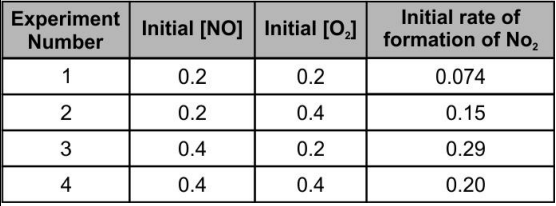Kamlesh was conducting an experiment to figure out the rate equation of the following reaction:
2NO+O2→2NO2
He measured the rate of this reaction as a function of initial concentrations of the reactants as follows:

Which of the following could be a reason for the inconsistency in the initial rate of formation of NO2 data for experiment 4?
The rate of reaction does not depend on the concentration of the reactants.
Higher concentration of O2 could have resulted in slowing down the rate of reaction.
Higher concentration of NO could have resulted in slowing down the rate of reaction.
The temperature of the reactants in experiment 4 could have been different than for the other experiments.
Step by step video & image solution for Kamlesh was conducting an experiment to figure out the rate equation of the following reaction: 2 NO + O_2 rightarrow 2 NO_2 He measured the rate of this reaction as a function of initial concentrations of the reactants as follows: Which of the following could be a reason for the inconsistency in the initial rate of formation of NO_2 data for experiment 4? by Chemistry experts to help you in doubts & scoring excellent marks in Class 12 exams.
Updated on:21/07/2023Topper's Solved these Questions
Similar Questions
Knowledge Check
What is the product of following reaction, NO+NO2→
AN2OBN2O3CN2O4DN2O5In a first order reaction A → B, if k is rate constant and initial concentration of the reactant A is 2 M then the half life of the reaction is:
Alog2kBlog2k√0.5Cln2kD0.6930.5kInitial concentration of reactant for nth order reaction is 'a'. Which of the following relations is correct about t1/2 of the reaction?
Alnt1/2= ln (constant)-(n-1) logeaBlnt1/2=ln n+ln (constant)-ln aCt1/2 ln n =ln (constant) + ln a0Dlnt1/2= n ln a0
Rate constant K = 2.303 min–1 for a particular reaction the initial concentration of the reactant is 1 mole/litre then rate of reaction after 1 minute is :-
View SolutionRate constnat K=2.303min−1 for a particular reactio the initial concentration of there reactant is 1 mole/litre then rate of reaction after 1 minute is
View SolutionRate constant k=2.303min−1 for a particular reaction. The initial concentration of the reaction is 1. mol/L, then rate of reaction after 1 minute is
View SolutionIn the following reaction, 2SO2(g)+O2(g)→2SO3(g) the rate of formation of SO3 is 100g/min. rate of disappearance of O2
View SolutionFor the reaction 2A+B → product, doubling the initial concentrations of both the reactants increases the rate by a factor of 8 and doubling the concentration of B above double the rate. This rate-law for the reaction is
View Solution
